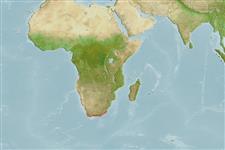>
Gobiiformes (Gobies) >
Gobiidae (Gobies) > Gobiinae
Etymology: Caffrogobius: Arabic kafir = to be unbelieving; infidel, a word given by Arabs to all non moslems and also the region of Caffraria in South Africa (Ref. 45335).
More on author: Barnard.
Environment: milieu / climate zone / depth range / distribution range
Écologie
marin; saumâtre démersal; profondeur 0 - 7 m (Ref. 5299). Subtropical
Southeast Atlantic: Namibia to East London, South Africa.
Taille / Poids / Âge
Maturity: Lm ? range ? - ? cm
Max length : 12.5 cm TL mâle / non sexé; (Ref. 11344)
Épines dorsales (Total): 7; Rayons mous dorsaux (Total): 9-11; Épines anales 1; Rayons mous anaux: 9 - 10. Body with spots forming irregular longitudinal rows; black spot on posterior end of spinous dorsal; large males with faint vertical bands anteriorly; all fins (except caudal fin) dusky (Ref. 2798).
Occurs in estuarine, intertidal and inshore waters; usually on mud (Ref. 5299).
Life cycle and mating behavior
Maturité | Reproduction | Frai | Œufs | Fécondité | Larves
Goren, M., 1996. A review of the southern African gobiid fish genus Caffrogobius Smitt, 1900. Spec. Publ. Smith Inst. Ichthyol. (57):1-28. (Ref. 12725)
Statut dans la liste rouge de l'IUCN (Ref. 130435)
Menace pour l'homme
Harmless
Utilisations par l'homme
Pêcheries: sans intérêt
Plus d'informations
Noms communsSynonymesMétabolismePrédateursÉcotoxicologieReproductionMaturitéFraiRassemblement de ponteFéconditéŒufsDéveloppement de l'œuf
RéférencesAquacultureProfil d'aquacultureSouchesGénétiqueElectrophoresesHéritabilitéPathologiesTraitementNutrientsMass conversion
Outils
Articles particuliers
Télécharger en XML
Sources Internet
Estimates based on models
Preferred temperature (Ref.
123201): 14.5 - 25.2, mean 19.4 °C (based on 94 cells).
Phylogenetic diversity index (Ref.
82804): PD
50 = 0.5078 [Uniqueness, from 0.5 = low to 2.0 = high].
Bayesian length-weight: a=0.00708 (0.00333 - 0.01504), b=3.09 (2.92 - 3.26), in cm total length, based on LWR estimates for this (Sub)family-body shape (Ref.
93245).
Niveau trophique (Ref.
69278): 3.3 ±0.55 se; based on food items.
Résilience (Ref.
120179): Haut, temps minimum de doublement de population inférieur à 15 mois (Preliminary K or Fecundity.).
Fishing Vulnerability (Ref.
59153): Low vulnerability (10 of 100).
